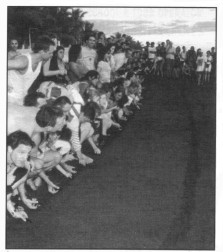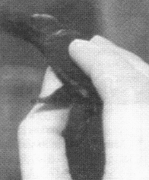
It's a race - except the winners must continue to struggle long after this finish line. The reward? Simply the opportunity to return one day, full grown, and pass the urgency of survival on to the next generation.
 On Your Mark, Get Set... |
The Center came up with the idea for the race as a way to garner a little extra money to help cover the costs of feeding and caring for the animals in their care. An area is cordoned off to hold back the crowd, giving the turtles a clear path to the sea. For 10 quetzales, spectators can sponsor a turtle. The starting line is drawn in the black sand halfway up the beach. The finish line, a couple meters away, decides the winner. The sponsor of the winning turtle can choose between a T-shirt, a tour from CECON-USAC or a dinner at one of the local restaurants.
Normally the hatchlings face the threats of fish, birds, and crabs. The massive release does create some strength in numbers. Additionally, the crowd keeps the birds at bay - for the moment at least - and at sunset the crabs have not yet taken the beach.
Back at CECON, eggs lie beneath the thatch-shaded sand in what looks like a vegetable garden. Sticks mark the nests and each is identified by a card with a nest number, date, number of eggs, and species name. There are 12 to 25 eggs in each nest. As the hatch date approaches, a small fence is laid around the egg site so that the hatchlings can be collected and kept in water-filled tanks until the Saturday night release.
At one time there were 250 species of sea turtles; now there are only eight worldwide. Of those eight, three species are indigenous to the southern coast of Guatemala: the Olive Ridley, the East Pacific Green, and the largest of the sea turtles, the Leatherback.
In the past there was a conflict between CECON-USAC and the locals. The precious turtle eggs provide income for the people of Monterrico who sell them and consume them as food. But a deal was reached, and it is required that local egg collectors give back 20% of everything they collect. When funds permit, the turtle center also buys additional eggs beyond that percentage.
 |
The Center, which houses caimans and iguanas in addition to its turtle project, offers group lectures and individual tours. The Center is open daily from 8:30-12:00, 2:00-5:30. Admission at present is free, but they are considering a nominal fee of 5 to 10 quetzales in the future. CECON-USAC, Monterrico, Taxisco, Departmento de Santa Rosa, tel: 613-0615.
--Review, Guatemala's English-language Magazine
January 2002
Year 10. no. 10, pp. 72, 84.